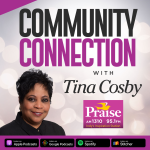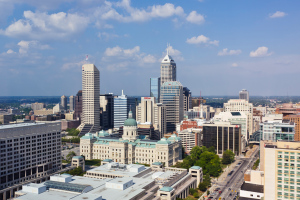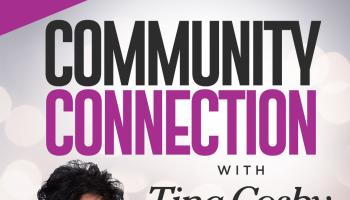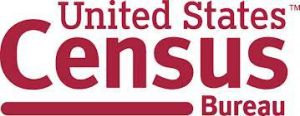
The Afternoons with Amos PODCAST For Friday, September 18, 2015 Features An EXCLUSIVE SPECIAL REPORT: Release of 2014 Census American Community Survey (ACS) Data. Seven years after the Great Recession began in 2008, and five years after it officially ended in 2010, there is a bit of evidence that while unemployment is falling, income growth is spotty and poverty continues stubbornly high in the state of Indiana and it’s in its largest and capitol city – Indianapolis. That’s the first of the conclusions found in the 2014 Census ACS released Thursday morning (September 17th) by the Census Bureau. Afternoons with Amos has begun analyzing the massive database of the 2014 Census ACS and found these points.
- A RECORD NUMBER – 194,960 Persons in Indianapolis were living below the Federal Povety level in 2014 reports the Census ACS. Highest number in poverty in city’s history.
- Indiana is one of twelve states, in all parts of the country, where the percentage and number of people in poverty declined.
- The percentage of families and individuals in poverty in Indianapolis and statewide– overall and African-American – continue to be at levels far higher than before the Great Recession.
- The actual number of persons in poverty in the state declined in 2014; one of twelve states where poverty fell. But the number of persons in poverty in Indianapolis increased.
- Despite declines, nearly a third of African-Americans in Indiana still and 3-in-10 in Indianapolis live below the poverty level.
- The number of African-Americans in poverty in Indianapolis fell in 2014; while Hispanics and white non-Hispanics in the city/county living in poverty increased.
- There is some improvement in Median Household Income for all households and Black households in the state and in Indianapolis.
- While there’s been a slight rebound, the percentage of Indianapolis households that are homeowners continues at record lows.
- Despite some reduction, African-American unemployment in Indianapolis/Marion County remains stubbornly high.
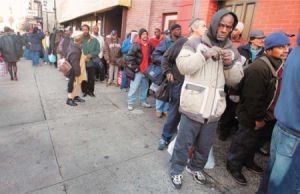
Source: Getty
Here are key highlights from our analysis: OVERALL POVERTY – In a stunner, the 2014 Census American Community Survey reports that the number of persons in poverty in America’s 11th largest city, Indianapolis/Marion County rose in 2014. Census ACS says 194,960 persons in the city/county lived in poverty in 2014. Not only is that up 1.4% from the 192,231 persons in the city/county that lived in poverty in 2013, it is the HIGHEST NUMBER of Indy residents in poverty in the city/county’s history! .In 2014, again over one-fifth of all Indianapolis residents lived in poverty, 21.4%, consistent with 21.2% in 2013; 21.5% in 2012; 21.1% in 2011 and 20.6% in 2010. Poverty for children under 18 was 32.3% in 2014, up from 30.4% in 2013, down from 32.8% in 2012, but comparable to 32.4% in 2011 and 30.8% in 2010. Since 2008, the number of persons in Indianapolis/Marion County living in poverty climbed a stunning 40.1%; twice the percentage of the rise of persons in poverty statewide. While the number of persons in the Indiana’s capitol living in poverty rose, the number of Hoosiers statewide living in poverty fell to 974,218. A decline of 4.0% from the record setting 1,015,127 Hoosiers in poverty in recorded in 2013. Indiana’s poverty rate was 15.2%, down from 15.9% in 2013; and 15.6% in 2012. Indiana is one of twelve states, in all parts of the country, where the percentage and number of people in poverty declined. The other states where poverty declined were: Arkansas, California, Colorado, Florida, Georgia, Michigan, Mississippi, North Carolina, Texas, Utah and Washington. But, despite the reduction in 2014, since the Great Recession, the number of Hoosiers in poverty has risen 20.6%. The percentage of families in Indiana’s capitol and largest city living in poverty in Indianapolis declined in 2014. The poverty rate for city/county families in 2014 was 16.5%; down from 17.7% in 2013; but about the same as the 16.6% in 2012; 16.5% in 2011 and 16.3% in 2010. Unfortunately, the poverty rate for families with children in the city/county increased again to 27.5% in 2014. Since 2010, over a quarter of Indianapolis’ families with children have lived below the poverty line. The Indy families with children poverty rate was 25.9% in 2013 & 2012; 26.5% in 2011 and 26.9% in 2010.
BLACK POVERTY – In Some Good News, the percentage and number of African-Americans living in poverty saw a significant decline. Some 29.5% of African-Americans in Indianapolis in 2014 lived below the poverty level. That’s down from 31.6% in 2013; 31.4% in 2012 and 29.0% in 2011; but up from 24.8% in 2010.
The actual number of African-Americans in the city/county in poverty in 2014 dropped sharply to 70,708 down from 78,239 in 2013; a decline of 9.6%. Paradoxically, the number of Hispanics and white non-Hispanics living in poverty in Indianapolis grew. Hispanics l in Indy living in poverty increased to 36,792 from 32,647; an increase of 12.7%. White non-Hispanics in Indy in poverty rose to 73,911 from 71,934; up 2.7%. White makeup 37.9% of Indy residents in Poverty; Blacks 36.2% and Hispanics 12.7%. The percent of African-American children under 18 living in poverty was 39.9%, down from 41.7% in 2013; 43.8% in 2012; 42.9% in 2011 but up from 35.2% in 2010. There was a strong decline in poverty among Black Indianapolis families with 26.5% of Black families living below the poverty level in 2014, compared to 30.4% of Black families living in poverty in 2013. The 2014 Black family poverty rate is close to the 25.4% in 2012 and 24.4% in 2011. Statewide, one-in-three African-Americans in Indiana, some 186,940 lived below the poverty level in 2014. That’s a decline of 1.7% from the 190,203 that was below the poverty level in 2013. Blacks in poverty in 2012 was 187,175. The Black poverty rate in 2014 was 32.5% in 2014 compared to 33.1% in 2013 and 32.9% in 2012. Hoosier Black families in poverty fell to 28.5% in 2014, compared to 31.3% in 2012; but up from 28.1% in 2012 and comparable to the figure of 30.2% in 2011.
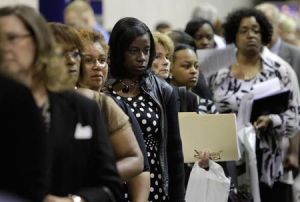
Source: Getty
OVERALL UNEMPLOYMENT – Overall unemployment continued to fall in Indianapolis in 2014 according to the 2014 Census ACS. In 2014 9.2% of Indianapolis adults aged 16 and over were unemployed, down from 10.6% in 2013; 11.0% in 2012; 12.0% in 2011 and 13.3% in 2010. In Indianapolis’ major townships, overall unemployment ranged all over the board. Highest unemployment was in Center Township 13.6%; Lawrence 10.6% and Wayne 9.6%, Pike 9.4%. Lowest unemployment was in Perry Township 6.8%; and Washington 7.9% Warren 8.3%. (Individual data for Decatur and Franklin Townships not available until December). Statewide, unemployment was 7.1% in 2014, down from 7.8% in 2013; 8.8% in 2012 and 10.0% in 2011.
BLACK UNEMPLOYMENT – Black unemployment in the city/county in 2014 was 16.1%, down a bit from 19.3% in 2013; and 19.6% in 2012. Of the six townships in Marion County with the largest Black population, Black unemployment was highest in Center Township 21.3%; Lawrence 20.9%; Washington 18.6%. It was lowest in Warren 15.9%; Pike Township 13.7%; and Wayne 13.7%. Unfortunately, statewide the Black unemployment rate INCREASED in 2014 to 16.9% in 2014 compared to 16.3% in 2013. Despite the jump, Black unemployment in 2014 was a still below the 19.1% figure in 2012 and 17.5% in 2011.

Source: Getty
HOUSEHOLD INCOME – There was a slight increase in Median Household Income for Indianapolis/Marion County Households in 2014 to $42,557, up from $41,345 in 2013, compared to $41,880 in 2012; $40,668 in 2011 and $41,533 in 2010.
Statewide, there was a more significant rise in Median Household Income in 2014 to $49,446, up from $47,529 in 2013; $47,541 in 2012 and $48,054 in 2011.
BLACK HOUSEHOLD INCOME – The 2014 Census ACS reported that Black median household income in Indianapolis also improved a bit in 2014 rising to $30,485 from $29,767 in 2013. Compared to Black median household income of $29,314 in 2012 and $29,599 in 2011, it’s the first time Black median income in the state’s capital city had crossed the $30,000 mark since the recession’s start.
Statewide, Black median household income rose to $30,116, from $29,794 in 2013; $28,469 in 2012 and $28,732 in 2011.
HOMEOWNERSHIP – Indianapolis’ anemic level of overall homeownership improved slightly in 2014 rising to 54.3% up from the record low of 52.9% recorded in 2013. But the figure is still lower than the 53.9% mark in 2012; 55.5% in 2011 and 57.5% in the Census year of 2010.
Since 2010, it’s estimated that the number of homeowners in Indianapolis has fallen by over 8,500 or some 4.2% in just five years.

Sen. Lonnie Randolph / State Website
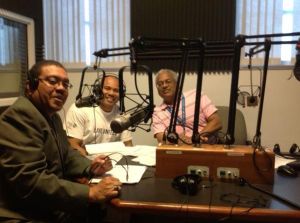
(l-R) Mark Russell, Urban League; Demetrius Glover, United Way; With Amos/Twitter via United Way
Reacting To The Data On The Afternoons with Amos Podcast For Friday, September 18th were State Senator Lonnie Randolph, head of the Indiana Black Legislative Caucus and Mark Russell, Director of Education, Indianapolis Urban League and Demetrius Glover, VP Strategic Information, United Way of central Indiana. Sen. Randolph reacted to the data as well as answered community questions and concerns during the Afternoons with Amos’; regular 3rd Friday of the month community conversation with Black legislators. Russell and Glover reacted to the full presentation of the data by Amos. (Sen. Randolph’s Interview and Reaction to Census ACS Data Starts At 1:11 Mark On PODCAST Media Player. Amos’ Full Presentation of the Data And Reaction from Russell and Glover Starts At 59:29 Mark On PODCAST Media Player.) Click the Link To Read/Download Detailed 2014 Census ACS Profile for Indianapolis/Marion County. 2014 CENSUS ACS DATA PROFILE FOR INDIANAPOLIS/MARION COUNTY

Democratic Mayor Candidate Joe Hogsett
OTHER KEY REACTION TO THE 2014 CENSUS ACS DATA: Both Indianapolis Mayor candidates were sent copies of the the Census ACS data for Indianapolis and asked to react. Republican Chuck Brewer didn’t respond. Democrat Joe Hogsett said: “The recent Census ACS data indicates that some progress has been made since the Great Recession, but much work remains. The next mayor must confront the dramatic rise in poverty in Indianapolis in recent years that now directly affects one in three children across our city. That’s why I have spent time talking to our community about education, public safety and neighborhood development—fundamental components of the vision I have to move Indianapolis forward and ensure none of our neighborhoods are left behind or forgotten.” Congressman Andre Carson Responded On Twitter:
Governor Mike Pence’s office responded by questioning whether the sample size of the Census ACS was large enough. (It surveys some 5.454 million people nationwide; 115,116 people in Indiana and 13,580 in Indianapolis).

Gov. Mike Pence
Gov. Pence’s Press Secretary Kara Brooks responded: “More importantly, the administration is working to increase opportunities so that the improved economy can be shared by all. The 2015-2016 biennial budget included a number of purposeful requests to expand opportunities for youth and adults, who are seeking higher education levels and new career opportunities. This includes more funding dedicated for career and technical education than ever before ($48M), an expansion of the State of Jobs for America’s Graduates program targeting at risk-students (Indiana has the largest program in the country), and the WorkOne Career Center locations around that state that offer a variety of job services including resume and interview assistance, Microsoft software workshops, direct job placement opportunities all free of charge. Indianapolis, as well as other areas, such as Northwest Indiana, have received considerable state education, training, and economic development resources because we understand that some areas of the state have the potential to remain at-risk economically even as Indiana continues a robust recovery from the Great Recession. This is not to say that we are satisfied, and that is why we continue to emphasize education and training.”

Mayor Greg Ballard
Brad Jacklin, Press Secretary to Mayor Greg Ballard responded to the data this way: “The data shows a mix of positive development as well as areas where more growth and opportunity is needed to address poverty in Indianapolis, especially for minority communities. The Great Recession took a heavy toll on individual wealth, especially for non-white households, but with employment up, housing prices going up, and redevelopment in Indianapolis neighborhoods creating more opportunities for residents, the situation continues to improve for families across the city. Just because the trend is in the right direction, it doesn’t mean our work is done to ensure all our residents have a chance to benefit from economic growth. The City of Indianapolis is working to equip our workforce with the tools for today’s jobs and to connect employers with qualified employees. The Office of Minority & Women Business Development operates programs designed to increase the skills of city residents and connects with them in their own neighborhoods. The City is also working to ensure that those who want to work are able to find jobs and that is why we supported Councillor (Vop) Osili’s Ban the Box ordinance and lobbied the state to do more with First Day In programs to ensure that ex-offenders aren’t penalized after they’ve paid their debt to society.”
The Afternoons with Amos PODCAST, Including Details On New 2014 Census ACS Data Runs 93 Minutes ©2015 WTLC/Radio One. PODCAST Starts After Brief Video Ad.





